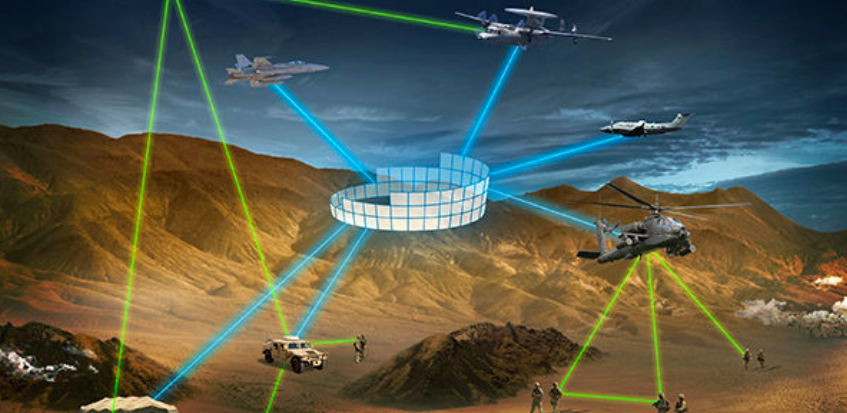
Link 16 is a tactical military data network, used by US and NATO air-, sea- and land-base platforms. (Viasat image.)
UPDATE: This story was updated 03/11/2023 at 4 pm ET to reflect a clarification by SDA about the process for approval of Link 16 usage.
WASHINGTON — The Space Development Agency (SDA) finally can begin testing Link-16 signals from its Transport Layer of data relay satellites in low Earth orbit, having just received approval from a key international regulatory body — although the agency remains caught up in a long-running Defense Department spat with the Federal Aviation Administration that is preventing use of the venerable military data/communications link over US territory.
“I’m glad to report SDA received a waiver through the National Telecommunications and Information Administration process for experimental testing of Link 16 from space from the radios being flown on some of the York Tranche 0 Transport satellites. The waiver, reviewed by the International Telecommunication Union (ITU), allows SDA to test over international water and over the territory of a Five Eyes ally,” SDA Director told Breaking Defense in an email today.
He did not, however, reveal which of those allies — Australia, Canada, New Zealand and the United Kingdom — are involved.
The ITU, headquartered in Geneva, manages electromagnetic spectrum usage that crosses borders to prevent interference. Individual nations, however, are responsible for allocating frequencies for various domestic uses and ensuring against interference inside their own borders. In the case of the United States, the semi-independent Federal Communications Commission is the chief regulatory body, but coordination of spectrum use among federal agencies is managed by the National Telecommunications and Information Administration.
SDA has already launched 19 Tranche 0 Transport Layer satellites, as the first test birds for its planned mesh network constellation to provide high volume, low latency communications between sensors and shooters across all domains — with the Transport Layer deemed by the Defense Department as the backbone of its planned Joint All Domain Command and Control (JADC2) network-of-networks. York Space Systems and Lockheed Martin won contracts in 2020 to each build 10, but one of the York birds is staying on the ground as a test vehicle.
Tournear explained that “testing Link 16 from space first over international waters and with an international partner, while important, represents a compromise position for SDA and our requirement remains to test over U.S. air space in order to demonstrate the feasibility of the Proliferated Warfighter Space Architecture and its ability to deliver space-based capabilities to the warfighter over existing tactical data links.
“This testing is absolutely critical to SDA’s on-time delivery,” he stressed.
For SDA, schedule is everything — after all its motto is Semper Citius, or always faster. The agency has ambitious plans to put some 400 of its Transport Layer satellites up by the end of 2028, developing and launching new variants, or Tranches, every two years. Further, the SDA acquisition model has been embraced by the Space Force and the Pentagon as the way of the future to keep ahead of China.
To allow testing over national airspace, SDA needs to resolve its dispute with the FAA, which comes under the Department of Transportation and is responsible for commercial aviation safety, over concerns that Link 16 signals being broadcast through space could interfere with the ability of civil aircraft radios to receive air traffic control radar signals. While the Link 16 line-of-sight communications network long has been used by US military forces and NATO allies for communications among air-, sea- and ground-based platforms, it has never been used by satellites.
Moreover, sources from both organizations told Breaking Defense that Link 16 has been a subject of bitter contention between DoD and the FAA for several years. Ubiquitous military Link 16 terminals, such as the Joint Tactical Information Distribution System (JTIDS) and the Multifunctional Information Distribution System (MIDS), use the 960 – 1215 MHz frequency band, as do civil radio-navigation systems. Thus, DoD is required, under a decades-old agreement with FAA, to ensure that all radio equipment using Link 16 has been tested and certified to meet NTIA standards against frequency interference.
And both FAA and DoD sources say the Pentagon has been lackadaisical about doing so. Indeed, a senior FAA official in September 2021 — an excerpt of which was provided to Breaking Defense — called DoD officials on the carpet for allowing “hundreds” of uncertified aircraft to participate in exercises in national airspace. And as Aviation Week first reported, the FAA last January moved to limit DoD access to the Link 16 frequency bands for all military air, sea and land systems.
Tournear, on Oct. 19 during the MilSat Symposium in Mountain View, Calif., admitted that part of the Link 16 stalemate is “on DoD” for being slow to certify the SDA satellite links.
To that end, he said in today’s email, SDA “continues to pursue” a temporary frequency assignment from the FAA, that would allow it to “begin testing with the support of military partners with battle-ready DOD instrumentation and personnel trained in such testing.”
Tournear added that the agency is “actively pursuing” what is called “Electromagnetic Compatibility Features (EMCF) validation” within DoD, required to prove that its Link 16 terminals to meet non-interference standards.
“We have done and will continue to do all that is within our agency’s power to prioritize the completion of the requested testing. In the meantime, SDA has provided significant data to FAA outlining the safety of Link16 during its long history of military use,” he said.
Several government and industry sources close to SDA-FAA discussions have indicated to Breaking Defense that senior Defense and Transportation officials now have weighed in to speed a deal. One government official elaborated that there are two proposed SDA demos on the table, one of which is probably more doable than the other.
“I suspect that SDA will get some relief after they do the full testing and have some mitigations they can use over the US,” said another government source.






















